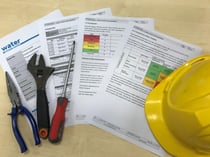One question our consultants are continuously asked by clients is “How are we compared to other organisations?”
Over the past few years, the Water Hygiene Centre has carried out thousands of Legionellosis Risk Assessments for a multitude of organisations and properties using our UKAS Accredited method and reports.
Why choose a UKAS accredited Legionella Risk Assessment?
One of the unique features of our UKAS Accredited method is the ability to produce risk scores for those properties and organisations that have had a risk assessment. Each risk assessment report generated compares properties within an organisation, but also compares risk scores against all other similar organisations that has been assessed by the Water Hygiene Centre.
As part of the hand-over meeting with all clients, they are presented with a League Table (Table 1), which shows where they are ranked.
This blog aims to interpret and analyse the data which we have collected over the past few years.
Table 1 shows the complete league table of organisations assessed over the last few years, both healthcare and non-healthcare (obviously the names of the organisations have been replaced by a description).
Table 1 – Complete League Table
|
Position |
Organisation |
Inherent Risk Score % |
Actual Risk Score % |
% Diff |
|
1 |
Community Health Trust |
84 |
84 |
0% |
|
2 |
College |
84 |
81 |
-4% |
|
3 |
Medium Acute Hospital Trust |
82 |
81 |
-1% |
|
4 |
Large University |
90 |
79 |
-12% |
|
5 |
Small Non-Acute Hospital Trust |
81 |
77 |
-5% |
|
6 |
Harbour Buildings |
84 |
75 |
-11% |
|
7 |
Medium University |
86 |
76 |
-12% |
|
8 |
Mental Health Trust |
76 |
73 |
-4% |
|
9 |
Law Enforcement Agency |
84 |
72 |
-14% |
|
10 |
Large Acute Hospital Trust |
75 |
71 |
-5% |
|
11 |
Schools |
85 |
71 |
-16% |
|
12 |
Large Acute Hospital Trust |
76 |
70 |
-8% |
|
13 |
Large Acute Hospital Trust |
72 |
70 |
-3% |
|
14 |
Education Buildings |
88 |
70 |
-20% |
|
15 |
Housing Association |
92 |
67 |
-27% |
|
16 |
Council |
86 |
67 |
-22% |
|
17 |
Leisure Centres |
89 |
67 |
-25% |
|
18 |
Airport |
78 |
67 |
-14% |
|
19 |
Community Health Trust |
76 |
66 |
-13% |
|
20 |
Large Acute Hospital Trust |
74 |
66 |
-11% |
|
21 |
Large Acute Hospital Trust |
73 |
66 |
-10% |
|
22 |
Mental Health Trust |
74 |
65 |
-12% |
|
23 |
Large Acute Hospital Trust |
68 |
65 |
-4% |
|
24 |
Large Acute Hospital Trust |
71 |
64 |
-10% |
|
25 |
Large Acute Hospital Trust |
68 |
64 |
-6% |
|
26 |
Large Acute Hospital Trust |
70 |
63 |
-10% |
|
27 |
Large Acute Hospital Trust |
68 |
63 |
-7% |
|
28 |
Large Acute Hospital Trust |
66 |
61 |
-8% |
|
29 |
Council Buildings |
82 |
61 |
-26% |
|
30 |
Large Acute Hospital Trust |
70 |
60 |
-14% |
|
31 |
Large Acute Hospital Trust |
70 |
60 |
-14% |
|
32 |
Community Health Trust |
77 |
59 |
-23% |
|
33 |
Community Health Trust |
80 |
59 |
-26% |
|
34 |
Housing Association |
81 |
56 |
-31% |
|
35 |
Large Acute Hospital Trust |
69 |
56 |
-19% |
|
36 |
Service/Commercial Buildings |
81 |
55 |
-32% |
|
37 |
Large Acute Hospital Trust |
55 |
55 |
0% |
|
38 |
Council Buildings |
86 |
53 |
-38% |
|
39 |
Sheltered Housing |
68 |
50 |
-26% |
|
40 |
Large Acute Hospital Trust |
60 |
50 |
-17% |
|
41 |
Care Home |
58 |
47 |
-19% |
|
42 |
Automotive Buildings |
75 |
46 |
-39% |
|
43 |
Medium Acute Hospital Trust |
46 |
44 |
-4% |
|
Average |
76 |
64 |
-14% |
BS 8580-1:2019 Water Quality. Risk assessments for Legionella control state that “The risk assessor should evaluate risk by appropriately combining factors and comparing the levels of risk with the level acceptable for each circumstance” by using “Risk Appetite” and “ALARP” (As low as reasonably practicable).
Firstly, you will also see a column for “Inherent Risk” and a column for “Actual Risk”. BS 8580 explains how “resources in an organisation are finite, so an understanding of inherent risk might help to ensure that the response is proportionate to the risk.”
 Inherent risk represents the risk before any action has been taken, it concerns the design and configuration of the system, typically a result of decisions made by designers, architects and procurement. Identifying which risks are “inherent” informs Estate Managers/Authorised Persons which risk assessment actions may need more/additional funding and commitment from the purse string holders. By showing an inherent risk score, it shows how good the cards which have been dealt to them are.
Inherent risk represents the risk before any action has been taken, it concerns the design and configuration of the system, typically a result of decisions made by designers, architects and procurement. Identifying which risks are “inherent” informs Estate Managers/Authorised Persons which risk assessment actions may need more/additional funding and commitment from the purse string holders. By showing an inherent risk score, it shows how good the cards which have been dealt to them are.
Secondly, “Actual Risk” now includes all risk factors of the water systems; Inherent, condition, performance and management. The last three being directly affected by management of those water systems.
A comparison between risk types reveal that on average there is a 14% increase in risk from Inherent to Actual. Indeed it is only the organisation sitting pretty in Position 1 that can boast that their risk management is as good as the water systems themselves.
From our data captured during the Legionella risk assessment, we can see how many of the risks at a site (be it from interview, inspection of records or physical asset assessment), meet or exceed their target (ALARP).
One of the first interpretations to make from Table 1 is that there are more non-healthcare organisations near the top, whereas large acute hospitals are more lower-mid table. This is because a non-healthcare organisation has a higher “Risk Appetite”, therefore will accept and tolerate more risk, decreasing their ALARP target. Non-healthcare organisations who house people generally with a lower susceptibility have the lower inherent risk systems (mains water & point-of-use water heaters), whereas the buildings in organisation serving the “immuno-compromised” population tend to have more complex water systems.
Table 2 confirms this, non-healthcare organisations have the lower risk water systems (83% versus 71% inherent risk scores).
Table 2 – Healthcare v Non-Healthcare
|
Organisation |
Inherent Risk Score % |
Actual Risk Score % |
% diff |
|
Healthcare Organisations |
71 |
64 |
-10 |
|
Non-Healthcare Organisations |
83 |
65 |
-22 |
However, it is not a surprise that this is the case. Actual risk includes aspects that can change very quickly i.e. temperature and condition, and also requires more continuous, everyday human interaction. Table 2 shows that Healthcare organisations do make up for more complex water systems by managing them more rigorously than non-healthcare organisations (10% difference compared to 22%).
To look into the stats more deeply, Healthcare Estate Managers/Responsible Persons/Authorised Persons reading this may want to know more about their type of organisation.
Table 3 – Hospital Types Comparison
|
Organisation |
Inherent Risk Score % |
Actual Risk Score % |
% diff |
|
Small non-acute Hospital |
81 |
77 |
-5 |
|
Non-Acute Hospitals |
78 |
69 |
-12 |
Table 3 shows how non-acute healthcare buildings have a much better Inherent Risk score, this is not surprising as these buildings include Health Centres, Clinics and cottage hospitals that do not require more complex water systems, for example, cold water storage tanks and air conditioning not being required.
What may be surprising is that the difference between Inherent and Actual Risk is greater in non-acute hospitals. This suggests that management in Acute Hospitals is better, which we all hope would be the case!
Table 4 – Hospital Size Comparison
|
Organisation |
Inherent Risk Score % |
Actual Risk Score % |
% Diff |
|
Single Site Organisations |
69 |
65 |
-7 |
|
Multiple Site Organisations |
73 |
64 |
-12 |
Table 4 shows the difference between hospital organisations that manage a single site compared to those managing multiple sites. What is interesting here is that the difference between Inherent and Actual Risks in multiple site healthcare organisations compared to single site organisations is greater.
Does this highlight the fact that those organisations with many properties are harder to manage? We only tend to deal with problems in front of us? With organisations such as community Trusts that have multiple small sites, it may be understandable that gathering and managing records/ppms can become difficult. Hospitals that are managed centrally, may receive more attention that its “satellites”.
Conclusion
Of course, the data captured is only as accurate as the Legionella risk assessor and represents a snapshot in time, it is also using the Water Hygiene Centres’ risk assessment method (albeit UKAS accredited). However, when the consultants and assessors look at the League Table, there is general approval of where organisations stand in relation to others.
There are also elements that cannot be disputed, for example, the organisations that have high Inherent Risk scores are those with simpler water systems (non-healthcare) and those that have a higher “ALARP” target (Acute Hospitals) have a much harder task getting to the top.
However, the League Table is a great way of showing where your organisation is compared to others. It also, in some cases, can be shown with pride to your Water Safety Group.
Feel free to reach out if you have any questions about this blog or if you would like to consult with one of our experts on water hygiene.
Editors Note: The information provided in this blog is correct at date of original publication - November 2017.
© Water Hygiene Centre 2019









